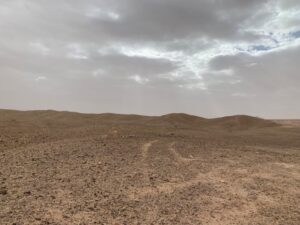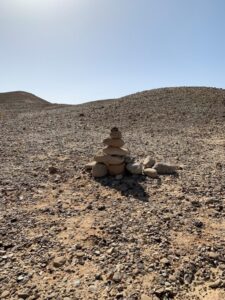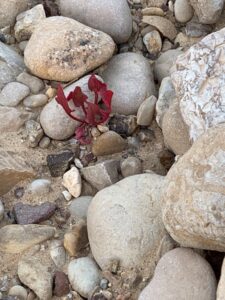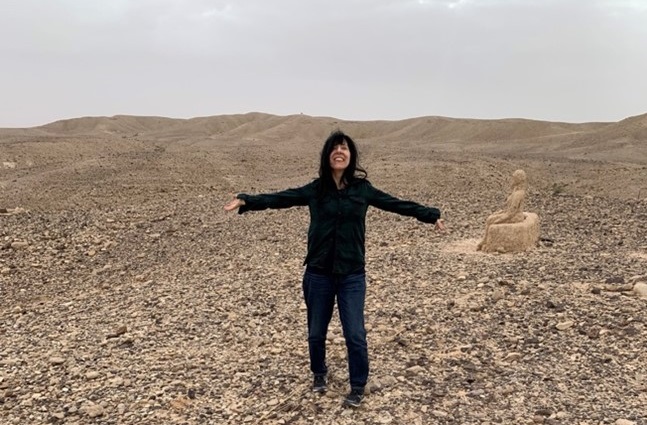In January 2019 I had the incredible opportunity to visit Yedidah Cohen in Israel. Yedidah had been my Kabbalah teacher for several years, and although we’d never met in person, we had established a deep and close relationship with each other. In the world of Kabbalah, most (almost all) teachers are men who are often rabbis as well. Yedidah was most definitely a trailblazer, not only because she is a woman teaching the Zohar, but she has also written several books interpreting the teachings of Rav Ashlag, considered to be the first modern Kabbalist. The plan was that I would arrive in the northern mountains of Tsfat, stay with Yedidah in her home where we would study and get to know each other, and then travel south to Jerusalem and onward to Midbar Aravah (the Aravah Desert). It was this desert land that became my unexpected sage, breaking me open in ways I could not have imagined.
Israel is a small country, (if you look it up on a map, it looks like this thin sliver surrounded by massive Arabic countries). Despite the size, the land is rich in an array of varied landscapes; from mountains, hills, valleys and deserts, to modern cities and ancient towns, with historical and biblical markers everywhere you go. The language and culture are inseparable, something that stood out coming from Canada/North America where culture is mostly found in compartmentalized communities. For example, on Friday afternoons, which is Erev (the eve of) Shabbat, the entire country prepares; all business closes by 1PM, taxi drivers sing songs in celebration, prayers spill out of synagogues everywhere, and in homes candles are lit and tables are prepared with challah and wine. When an entire country honors this tradition every week, you cannot help but feel transported into a wonderland.
By the time Yedidah and I were on our way to the desert, our connection and flow had proven effortless and deeply compatible; we believed ourselves to be soulmates, surpassing teacher/student and friends. Despite this, as the bus carried us further along the Jordan River, I could feel the air shifting, and I could not shake the unexplainable uneasiness that overwhelmed me.
 Midbar Aravah as it turned out, was not the romantic vision of a desert built of flowy sands and hot sun. For one, it was January, so there were cold winds, but more predominantly, it was composed mostly of rocks and dry hard earth. There were some hills, but they too leveled out back into the vast rocky earthscape with no end in sight. Besides a few small rugged-like trees, my initial impression was that nothing much could grow here, which I found very hard to connect with.
Midbar Aravah as it turned out, was not the romantic vision of a desert built of flowy sands and hot sun. For one, it was January, so there were cold winds, but more predominantly, it was composed mostly of rocks and dry hard earth. There were some hills, but they too leveled out back into the vast rocky earthscape with no end in sight. Besides a few small rugged-like trees, my initial impression was that nothing much could grow here, which I found very hard to connect with.
It did not take long, and I was in full panic mode. Strange fears began to arise – of becoming lost if I wandered too far from our prepared mud hut, of concern for my legs having to navigate the challenging ground, and of a deep impending sense of isolation. Yedidah on the other hand was completely entranced and excited by all of this. I watched her and mentally noted that there was another way for me here, but it was difficult as everything looked so barren, and a long-suppressed loneliness inside of me was now bubbling up. Part of me could not understand why we had come here.
So, it was the walking that changed everything.
At first our ventures away from our mud and straw home were short, because the duotone horizon seemed to wash out everything, leaving no points of reference to rely on. But eventually we discovered that jewels lay everywhere. The first of these were sculptured rock cairns that seemed to appear out of nowhere, offering themselves as markers. All it took was walking one step too far and for the ground to dip just so much, for our home’s landmark to vanish from sight along with no clear direction back. The cairns offered reassurance and of course a reminder that others had been here before us, which eased my anxiety slightly.

As my confidence increased and we ventured off for longer distances, I noticed that things were not as I had judged them to be. Hidden in and around the rocks were these tiny plants that you would miss if you weren’t paying attention, stretching delicate but hearty stems and leaves just so, seemingly giggling with brilliant-colored blossoms. I wondered at the strength and perseverance that it must have taken for them to push through this hard ground. It felt awesome to discover them, and they felt truly magical and otherworldly. How they sustained themselves was a mystery to me, but much later Yedidah would note, We were brought up in environments which were not nurturing, yet somehow we held on and flowered.

We lived in Midbar Aravah a mere 3 days and yet it felt like so much longer. Our time included late nights by the fire with fresh lemon ginger tea, and the clearest sky of stars we’d ever seen. As more walks unfolded, I learned to trust that no matter how far I went, the land would always lead me back somehow. I discovered a hidden strength within me, which then launched the beginning of a new and more conscious healing journey of reconciliation and belonging.
Teachers come in all forms. This one gratefully unexpected. Appropriately introduced to me by another, the beautiful and wise woman who I continue to study with long distance, until we meet again.
©2021 Diane Barbarash

